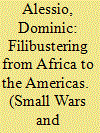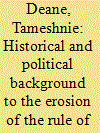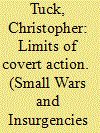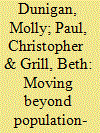| Srl | Item |
| 1 |
ID:
148049


|
|
|
|
|
| Summary/Abstract |
This article looks at dominant definitions of empire, in particular those emphasizing large polities as the sole agents of imperial expansion. By doing so, it draws attention to the overlooked role of filibusters: private, non-state actors who initiate unauthorized military endeavours, either in an attempt to carve out empires for themselves or for their home state. It demonstrates that filibustering is not a practice unique only to the Americas or to the nineteenth century as so much of the literature suggests. Lastly, it scrutinizes the cultural and historical impact of the phenomenon. In terms of the former, it argues that filibustering had an important literary and filmic influence. Regarding the latter, it advocates that it frequently led to further violent intercessions in many of the countries occupied and influenced a particular style of proto-fascistic and charismatic militarism.
|
|
|
|
|
|
|
|
|
|
|
|
|
|
|
|
| 2 |
ID:
148045


|
|
|
|
|
| Summary/Abstract |
reflection of deepening divides along political and ethnic lines. During this civil war the Sri Lankan Government and its security forces have been implicated in unlawful killings carried out in a pervasive manner against civilians, whilst at the same time specifically targeting ethnic Tamils, humanitarian workers and journalists. The human rights of all citizens suffered as a result and ultimately led to the weakening of the rule of law. With the end of the civil war, the Sri Lankan Government has made little progress in providing accountability for wartime abuses. Its absence of and reluctance to ensure justice is seen as a logical culmination of decades of impunity. The importance of acknowledging historical behaviour and taking accountability for past violations will be discussed. In an analysis for paving the way to a new democracy in Sri Lanka, the main outcomes of this article are calls for accountability arising out of the government’s actions during the war; an investigation into the present state of human rights, the rule of law and finally; an examination into the political solution going forward to ensure a process of reconciliation and peaceful co-existence.
|
|
|
|
|
|
|
|
|
|
|
|
|
|
|
|
| 3 |
ID:
148046


|
|
|
|
|
| Summary/Abstract |
This article evaluates the performance of the Special Air Service (SAS) during secret cross-border raids conducted as part of Britain’s undeclared war against Indonesia from 1963–1966. The analysis reviews the existing debate on the SAS’ performance during this campaign; it looks more closely at how military effectiveness might be defined; and it then examines, using the SAS’ own operations reports, the nature of their activities and their success or failure. This article concludes that critics of the SAS’ effectiveness during Confrontation are right; but for the wrong reasons. SAS operations did indeed have less effect than orthodox accounts would have it. But the reasons for this lay not in their misuse but in the exigencies of British strategy. This article demonstrates an enduring truth – no matter how ‘special’ a military force might be, tactical excellence cannot compensate reliably for problems in strategy.
|
|
|
|
|
|
|
|
|
|
|
|
|
|
|
|
| 4 |
ID:
148047


|
|
|
|
|
| Summary/Abstract |
Historically, insurgency is one of the most prevalent forms of armed conflict and it is likely to remain common in the foreseeable future. Recent experiences with counterinsurgency in Iraq and Afghanistan offer many lessons for future counterinsurgents, but the discourse on the subject continues to be mired in a traditional dichotomy pitting population-centric approaches to counterinsurgency against enemy-centric approaches. Historical analysis suggests that this traditional dichotomy is not a sufficiently nuanced way to understand or plan for such operations. Instead, discussions of counterinsurgency should focus on two dimensions: actions (use of physical force vs. political or moral actions) and targets (active insurgents vs. insurgent support). This perspective divides the space of possible counterinsurgency efforts into four quadrants, suggesting that effective counterinsurgency campaigns find a balance of effort across the four quadrants that is well matched to the specific context.
|
|
|
|
|
|
|
|
|
|
|
|
|
|
|
|